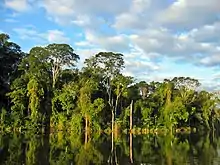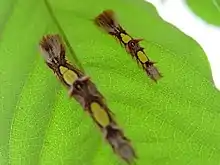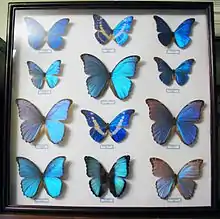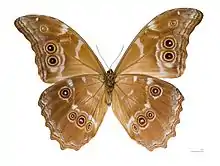Morpho
The morpho butterflies comprise many species of Neotropical butterfly under the genus Morpho. This genus includes more than 29 accepted species and 147 accepted subspecies, found mostly in South America, Mexico, and Central America.[1] Morpho wingspans range from 7.5 cm (3.0 in) for M. rhodopteron to 20 cm (7.9 in) for M. hecuba, the imposing sunset morpho. The name morpho, meaning "changed" or "modified", is also an epithet.
| Morpho butterfly | |
|---|---|
 | |
| Morpho didius, museum specimen | |
| Scientific classification | |
| Kingdom: | Animalia |
| Phylum: | Arthropoda |
| Class: | Insecta |
| Order: | Lepidoptera |
| Family: | Nymphalidae |
| Tribe: | Morphini |
| Genus: | Morpho Fabricius, 1807 |
| Type species | |
| Morpho achilles | |
| Diversity | |
| c. 29 species and 150 subspecies | |
| Synonyms | |
| |
Taxonomy and nomenclature
Many names attach to the genus Morpho. The genus has also been divided into subgenera. Hundreds of form, variety, and aberration names are used among Morpho species and subspecies. One lepidopterist[2] includes all such species within a single genus, and synonymized many names in a limited number of species. Two other lepidopterists[3] use a phylogenetic analysis with different nomenclature. Other authorities accept many more species.[4]
Etymology
The genus name Morpho comes from an Ancient Greek epithet μορφώ, roughly "the shapely one", for Aphrodite, goddess of love and beauty.
Species
This list is arranged alphabetically within species groups.[5]
Subgenus Iphimedeia
- Species group hercules
- Morpho amphitryon Staudinger, 1887
- Morpho hercules (Dalman, 1823) – Hercules morpho
- Morpho richardus Fruhstorfer, 1898 – Richard's morpho
- Species group hecuba
- Morpho cisseis C. Felder & R. Felder, 1860 – Cisseis morpho
- Morpho hecuba (Linnaeus, 1771) – sunset morpho
- Species group telemachus
- Morpho telemachus (Linnaeus, 1758)
- Morpho theseus Deyrolle, 1860 – Theseus morpho
Subgenus Iphixibia
- Morpho anaxibia (Esper, 1801)
Subgenus Cytheritis
- Species group sulkowskyi
- Morpho sulkowskyi – Sulkowsky's morpho
- Species group lympharis
- Morpho lympharis Butler, 1873 – Lympharis morpho
- Species group rhodopteron
- Morpho rhodopteron Godman & Salvin, 1880
- Species group portis
- Morpho portis (Hübner, [1821])
- Morpho thamyris C. Felder & R. Felder, 1867 – Thamyris morpho – or as a subspecies of M. portis
- Species group zephyritis
- Morpho zephyritis Butler, 1873 – Zephyritis morpho
- Species group aega
- Morpho aega (Hübner, [1822]) – Aega morpho
- Species group adonis
- Morpho eugenia Deyrolle, 1860 – Empress Eugénie morpho
- Morpho marcus (Cramer, 1775)
- Morpho uraneis Bates, 1865
Subgenus Balachowskyna
- Morpho aurora – Aurora morpho
Subgenus Cypritis
- Species group cypris
- Morpho cypris Westwood, 1851 – Cypris morpho
- Species group rhetenor
- Morpho helena Staudinger, 1890 – Helena blue morpho
- Morpho rhetenor (Cramer, [1775]) – Rhetenor blue morpho
Subgenus Pessonia
- Species group polyphemus
- Morpho luna Butler, 1869 or as subspecies Morpho polyphemus luna
- Morpho polyphemus Westwood, [1850] – (Polyphemus) white morpho
- Species group catenaria
- Morpho catenarius Perry, 1811 or as a subspecies of M. epistrophus
- Morpho epistrophus (Fabricius, 1796) – Epistrophus white morpho
- Morpho laertes (Drury, 1782) may be a synonym of M. epistrophus
Subgenus Crasseia
- Species group menelaus
- Morpho amathonte (Deyrolle, 1860) or as a subspecies of M. menelaus
- Morpho didius Hopffer, 1874 – giant blue morpho – or as a subspecies of M. menelaus
- Morpho godarti (Guérin-Méneville, 1844) – Godart's morpho – or as a subspecies of M. menelaus
- Morpho menelaus (Linnaeus, 1758) – Menelaus blue morpho
Subgenus Morpho
- Species group deidamia
- Morpho deidamia (Hübner, [1819]) – Deidamia morpho
- Morpho granadensis Felder and Felder, 1867 – Granada morpho – or as a subspecies of M. deidamia
- Species group helenor
- Morpho helenor (Cramer, 1776) – Helenor blue morpho or common blue morpho
- Morpho peleides Kollar, 1850 – Peleides blue morpho, common morpho, or the emperor
- Species group achilles
- Morpho achilles (Linnaeus, 1758) – Achilles morpho
Ungrouped:
- Morpho absoloni May, 1924
- Morpho athena Otero, 1966
- Morpho niepelti Röber, 1927
Coloration
Many morpho butterflies are colored in metallic, shimmering shades of blues and greens. These colors are not a result of pigmentation, but are an example of iridescence through structural coloration. Specifically, the microscopic scales covering the morpho's wings reflect incident light repeatedly at successive layers, leading to interference effects that depend on both wavelength and angle of incidence/observance.[7] Thus, the colors appear to vary with viewing angle, but they are surprisingly uniform, perhaps due to the tetrahedral (diamond-like) structural arrangement of the scales or diffraction from overlying cell layers. The wide-angle blue reflection property can be explained by exploring the nanostructures in the scales of the morpho butterfly wings.[8] These optically active structures integrate three design principles leading to the wide-angle reflection: Christmas tree-like shaped ridges, alternating lamellae layers (or "branches"), and a small height offset between neighboring ridges. The reflection spectrum is found to be broad (about 90 nm) for alternating layers and can be controlled by varying the design pattern. The Christmas tree-like pattern helps to reduce the directionality of the reflectance by creating an impedance matching for blue wavelengths. In addition, the height offset between neighboring ridges increases the intensity of reflection for a wide range of angles. This structure may be likened to a photonic crystal. The lamellate structure of their wing scales has been studied as a model in the development of biomimetic fabrics, dye-free paints, and anticounterfeit technology used in currency.
The iridescent lamellae are only present on the dorsal sides of their wings, leaving the ventral sides brown.
The ventral side is decorated with ocelli (eyespots). In some species, such as M. godarti, the dorsal lamellae are so thin that ventral ocelli can peek through. While not all morphos have iridescent coloration, they all have ocelli. In most species, only the males are colorful, supporting the theory that the coloration is used for intrasexual communication between males. The lamellae reflect up to 70% of light falling on them, including any ultraviolet. The eyes of morpho butterflies are thought to be highly sensitive to UV light, so the males are able to see each other from great distances. Some South American species are reportedly visible to the human eye up to one kilometer away.
Also, a number of other species exist which are tawny orange or dark brown (for instance M. hecuba and M. telemachus). Some species are white, principal among these being M. catenarius and M. laertes. An unusual species, fundamentally white in coloration, but which exhibits a stunning pearlescent purple and teal iridescence when viewed at certain angles, is the rare M. sulkowskyi. Some Andean species are small and delicate (M. lympharis). Among the metallic blue Morpho species, M. rhetenor stands out as the most iridescent of all, with M. cypris a close second. Indeed, M. cypris is notable in that specimens mounted in entomological collections exhibit color differences across the wings if they are not 'set' perfectly flat. Many species, like M. cypris and M. rhetenor helena have a white stripe pattern on their colored blue wings as well.[9]
Celebrated author and lepidopterist Vladimir Nabokov described their appearance as "shimmering light-blue mirrors".[10]
Sexual dimorphism
The blue morpho species exhibit sexual dimorphism. In some species (for instance M.adonis, M. eugenia, M. aega, M. cypris, and M. rhetenor), only the males are iridescent blue; the females are disruptively colored brown and yellow. In other species (for instance M. anaxibia, M. godarti, M. didius, M. amathonte, and M. deidamia), the females are partially iridescent, but less blue than the males.
Habitat

Morpho butterflies inhabit the primary forests of the Amazon and Atlantic. They also adapted to breed in a wide variety of other forested habitats – for instance, the dry deciduous woodlands of Nicaragua and secondary forests. Morphos are found at altitudes between sea level and about 1,400 m (4,600 ft).
Biology
- Morphos are diurnal, as males spend the mornings patrolling along the courses of forest streams and rivers. They are territorial and chase any rivals. Morphos typically live alone, excluding in the mating season.
- The genus Morpho is palatable, but some species (such as M. amathonte) are very strong fliers; birds—even species which are specialized for catching butterflies on the wing—find it very hard to catch them.[11] The conspicuous blue coloration shared by most Morpho species may be a case of Müllerian mimicry,[12] or may be 'pursuit aposematism'.[13]
- The eyespots on the undersides of the wings of both males and females may be a form of automimicry in which a spot on the body of an animal resembles an eye of a different animal to deceive potential predator or prey species, to draw a predator's attention away from the most vulnerable body parts, or to appear as an inedible or even dangerous animal.[14]
- Predators include royal flycatchers, jacamars and other insectivorous birds, frogs, and lizards.
Behavior
Morphos have a very distinctive, slow, bouncy flight pattern due to the wing area being enormous relative to the body size.
Life cycle
The entire life cycle of the morpho butterfly, from egg to death, is about 115 days.


The larvae hatch from pale-green, dewdrop-like eggs. The caterpillars have reddish-brown bodies with bright lime-green or yellow patches on their backs. Its hairs are irritating to human skin, and when disturbed it secretes a fluid that smells like rancid butter from eversible glands on the thorax. The strong odor is a defense against predators. They feed on a variety of plants. The caterpillar molts five times before entering the pupal stage. The bulbous chrysalis is pale green or jade green and emits a repulsive, ultrasonic sound when touched.[15] It is suspended from a stem or leaf of the food plant.[16]
The adults live for about two to three weeks. They feed on the fluids of fermenting fruit, decomposing animals, tree sap, fungi, and nutrient-rich mud.[17] They are poisonous to predators due to toxins they sequestered from plants on which they fed as caterpillars.
The more common blue morphos are reared en masse in commercial breeding programs. The iridescent wings are used in the manufacture of jewelry and as inlay in woodworking. Papered specimens are sold with the abdomen removed to prevent its oily contents from staining the wings. Significant numbers of live specimens are exported as pupae from several Neotropical countries for exhibition in butterfly houses. Unfortunately, due to their irregular flight pattern and size, their wings are frequently damaged when in captivity.
Host plants
Morpho larvae, variously according to species and region, feed on Leguminosae, Gramineae, Canellaceae, Guttiferae, Erythroxylaceae, Myrtaceae, Moraceae, Lauraceae, Sapindaceae, Rhamnaceae, Euphorbiaceae, Musaceae, Palmae, Menispermaceae, Tiliaceae, Bignoniaceae, and Menispermaceae.
According to Penz and DeVries[3] the ancestral diet of larval Satyrinae is Poaceae or other monocots. Many morphos have switched to dicots on several occasions during their evolutionary history, but basal species have retained the monocot diets.
Collectors

Morpho butterflies, often very expensive, have always been prized by extremely wealthy collectors. Famous collections include those of the London jeweler Dru Drury and the Dutch merchant Pieter Teyler van der Hulst, the Paris diplomat Georges Rousseau-Decelle, the financier Walter Rothschild, the Romanov Grand Duke Nicholas Mikhailovich of Russia and the, English and German respectively, businessmen James John Joicey and Curt Eisner. In earlier years, Morphos graced cabinets of curiosities "Kunstkamera" and royal cabinets of natural history notably those of Tsar of Russia Peter the Great, the Austrian empress Maria Theresa and Ulrika Eleonora, Queen of Sweden. More famous is Maria Sibylla Merian, who was not wealthy.
The people along the Rio Negro in Brazil once exploited the territorial habits of the blue morpho (M. menelaus) by luring them into clearings with bright blue decoys. The collected butterfly wings were used as embellishment for ceremonial masks. Adult morpho butterflies feed on the juices of fermenting fruit with which they may also be lured. The butterflies wobble in flight and are easy to catch.
Gallery
 M. didius – ventral side: Predatory birds aim their attack at the most prominent feature, the ocelli, missing the body entirely.
M. didius – ventral side: Predatory birds aim their attack at the most prominent feature, the ocelli, missing the body entirely. M. peleides, note the symmetric notches left by a bird beak
M. peleides, note the symmetric notches left by a bird beak M. polyphemus, one of several "white morpho" species
M. polyphemus, one of several "white morpho" species M. rhetenor – this museum specimen is used for education, but thousands are killed for domestic displays, sold to tourists or in gift shops.
M. rhetenor – this museum specimen is used for education, but thousands are killed for domestic displays, sold to tourists or in gift shops. M. richardus sunning itself for warmth
M. richardus sunning itself for warmth
 M. hecuba size comparison with M. thamyris (M. portis)
M. hecuba size comparison with M. thamyris (M. portis) The closed wings of this morpho butterfly are damaged, allowing some of the blue to show.
The closed wings of this morpho butterfly are damaged, allowing some of the blue to show.
Illustrations
 Maria Sibylla Merian Metamorphosis Insectorum Surinamensium 1705
Maria Sibylla Merian Metamorphosis Insectorum Surinamensium 1705 Pieter Cramer and Caspar Stoll De Uitlandsche Kapellen 1775–1782
Pieter Cramer and Caspar Stoll De Uitlandsche Kapellen 1775–1782 Pieter Cramer and Caspar Stoll De Uitlandsche Kapellen 1775–1782
Pieter Cramer and Caspar Stoll De Uitlandsche Kapellen 1775–1782 George Shaw and Frederick Polydore NodderThe Naturalist's Miscellany 1789–1813
George Shaw and Frederick Polydore NodderThe Naturalist's Miscellany 1789–1813 Hübner Sammlung exotischer Schmetterlinge Augsburg [1806-1841
Hübner Sammlung exotischer Schmetterlinge Augsburg [1806-1841 Hippolyte Lucas Histoire Naturelle des Lepidopteres Exotiques Paris,1835.
Hippolyte Lucas Histoire Naturelle des Lepidopteres Exotiques Paris,1835. Cajetan and Rudolf Felder Reise der Österreichischen Fregatte Novara um die Erde in den Jahren 1857, 1858, 1859
Cajetan and Rudolf Felder Reise der Österreichischen Fregatte Novara um die Erde in den Jahren 1857, 1858, 1859 Frederick DuCane Godman and Osbert Salvin Biologia Centrali-Americana 1879–1915
Frederick DuCane Godman and Osbert Salvin Biologia Centrali-Americana 1879–1915 Adalbert Seitz Die Gross-Schmetterlinge der Erde 1860–1938
Adalbert Seitz Die Gross-Schmetterlinge der Erde 1860–1938
See also
References
- Le Moult, E. & Réal, P. (1962–63). Les Morpho d'Amérique du Sud et Centrale. Paris: Editions du cabinet entomologique E. Le Moult.CS1 maint: uses authors parameter (link)
- Lamas, G. (Ed.) (2004) Checklist: Part 4A. Hesperioidea-Papilionoidea Archived 2008-06-22 at the Wayback Machine. Gainesville, Florida: Association for Tropical Lepidoptera. ISBN 0-945417-28-4
- Penz, Carla M.; DeVries, P. J. (2002). "Phylogenetic analysis of Morpho butterflies (Nymphalidae, Morphinae): Implications for classification and natural history" (PDF). American Museum Novitates. 3374 (3374): 1–33. doi:10.1206/0003-0082(2002)374<0001:PAOMBN>2.0.CO;2. hdl:2246/2863. ISSN 0003-0082.
- sv:Morpho Species 2000 and Itis
- Savela, Markku. "Morpho Fabricius, 1807". Lepidoptera and Some Other Life Forms. Retrieved October 1, 2018.
- Potyrailo, Radislav A.; Bonam, Ravi K.; Hartley, John G.; Starkey, Timothy A.; Vukusic, Peter; Vasudev, Milana; Bunning, Timothy; Naik, Rajesh R.; Tang, Zhexiong; Palacios, Manuel A.; Larsen, Michael; Le Tarte, Laurie A.; Grande, James C.; Zhong, Sheng; Deng, Tao (2015). "Towards outperforming conventional sensor arrays with fabricated individual photonic vapour sensors inspired by Morpho butterflies". Nature Communications. 6: 7959. doi:10.1038/ncomms8959. PMC 4569698. PMID 26324320.
- P. Vukusic; J.R. Sambles; C.R. Lawrence & R.J. Wootton (1999). "Quantified interference and diffraction in single Morpho butterfly scales" (PDF). Proceedings of the Royal Society B. 266 (1427): 1403–11. doi:10.1098/rspb.1999.0794. PMC 1690093. Archived from the original (PDF) on 2011-07-16.
- Siddique, R. H.; Diewald, S.; Leuthold, J.; Hölscher, H. (2013). "Theoretical and experimental analysis of the structural pattern responsible for the iridescence of Morpho butterflies". Optics Express. 21 (12): 14351–14361. doi:10.1364/OE.21.014351. PMID 23787623.
- Leach, William (2013). Butterfly People. New York: Pantheon Books. p. 201. ISBN 9780307907875.
- Young, Allen M. (1971). "Wing colouration and reflectance in Morpho butterflies as related to reproductive behaviour and escape from avian predators". Oecologia. 7 (3): 209–222. doi:10.1007/bf00345212. PMID 28311247. S2CID 25970574.
- Pinheiro, Carlos E. G. (1996). "Palatability and escaping ability in Neotropical butterflies: tests with wild kingbirds (Tyrannus melancholicus, Tyrannidae)". Biological Journal of the Linnean Society. 59 (4): 351–363. doi:10.1111/j.1095-8312.1996.tb01471.x.
- Edmunds M. 1974. Defence in Animals: a survey of anti-predator defences. Harlow, Essex and NY: Longman. ISBN 0-582-44132-3. On pp. 255–256 there is a discussion of 'pursuit aposematism': "Young suggested that the brilliant blue colours and bobbing flight of Morpho butterflies may induce pursuit... Morpho amathonte is a very fast flier... It is possible that birds that have chased several unsuccessfully may learn not to pursue butterflies of that [type]... In one area, Young found that 80% of less brilliant species of Morpho had beak marks on their wings... but none out of 31 M. amathonte." .. "If brilliant colour was a factor in courtship, then the conflicting selection pressures of sexual selection and predator selection might lead to different results in quite closely related species."
- Stevens, Martin (2005). "The role of eyespots as anti-predator mechanisms, principally demonstrated in the Lepidoptera". Biological Reviews. 80 (4): 573–588. doi:10.1017/S1464793105006810. PMID 16221330. S2CID 24868603.
- Nussbaum, Greg. Blue Morpho
- Fruhstorfer, H. (1913). "Family: Morphidae", pp. 333–356 in A. Seitz (editor), Macrolepidoptera of the World, vol. 5. Stuttgart: Alfred Kernen.
- Blue Morpho Butterfly (Morpho peleides). Rainforest Alliance. Retrieved on 2011-10-17.
Further reading
- Bilotta, I (1992). "Morfologia comparada da cabeça das especies sulbrasileiras de Morphinae (Lepidoptera,Nymphalidae)". Revista Brasileira de Zoologia. 9 (3–4): 261–271. doi:10.1590/s0101-81751992000200012.
- Bilotta, I (1994). "Morfologia comparada do torax das especies sulbrasileiras de Morphinae (Lepidoptera,Nymphalidae)". Revista Brasileira de Zoologia. 11: 691–713. doi:10.1590/s0101-81751994000400014.
- Bilotta, I (1994). "Morfologia comparada do abdome das especies sulbrasileiras de Morphinae(Lepidoptera, Nymphalidae)". Revista Brasileira de Zoologia. 11 (4): 737–748. doi:10.1590/s0101-81751994000400016.
- Blandin, P. (2007). The Systematics of the Genus Morpho, Lepidoptera Nymphalidae Hillside Books, Canterbury.
- Blandin, P. (1988). The genus Morpho, Lepidoptera Nymphalidae. Part 1. The subgenera Iphimedeia and Schwartzia. Sciences Nat, Venette.
- Blandin, P. (1993). The genus Morpho, Lepidoptera Nymphalidae. Part 2. The subgenera Iphixibia, Cytheritis, Balachowskyna, and Cypritis. Sciences Nat, Venette.
- Blandin, P. (2007). The genus Morpho, Lepidoptera Nymphalidae. Part 3. The Subgenera Pessonia, Grasseia and Morpho and Addenda to Parts 1 & 2. Hillside Books, Canterbury. Blandin The genus Morpho. Pt. 3.
- Fruhstorfer, H. (1912–1913). 6. Familie: Morphidae in Seitz, A. Die Gross-Schmetterlinge der Erde (The Macrolepidoptera of the World) Erde 5: 333–344 (31 May 1912),: 345–352 (5 June 1913),: 353–356 (8 July 1913).
- Penz, C.M.; DeVries, P.J. (2002). "Phylogenetic analysis of Morpho butterflies (Nymphalidae, Morphinae): implications for classification and natural history" (PDF). American Museum Novitates. 3374: 1–33. doi:10.1206/0003-0082(2002)374<0001:paombn>2.0.co;2. Archived from the original (PDF) on 2014-03-15.
- Schäffler, Oliver and Frankenbach, Thomas. (2009). Schmetterlinge der Erde Part 30, Nymphalidae XV: Morpho I Keltern: Goecke & Evers ISBN 978-3-937783-44-4 includes Morpho niepelti and M. theseus.
- Schäffler, Oliver and Frankenbach,Thomas, (2010). Schmetterlinge der Erde Part 33, Nymphalidae XVIII: Morpho II Keltern: Goecke & Evers ISBN 978-3-937783-48-2 ISBN 978-3-937783-49-9 Includes M. hercules, M. richardus, M. telemachus, M. amphitryon, M. hecuba, and M. cisseis.
- Takahashi, Mayumi. (1973). Notes on the genus Morpho (Lepidoptera: Morphidae) collected in the Santa Marta mountains, Colombia, South America. Tyô to Ga 24(4): 107–111, 26 figs.[general; ecology; behavior]
- Young, Allen M (1979). "The evolution of eyespots in tropical butterflies in response to feeding on rotting fruit: an hypothesis". Journal of the New York Entomological Society. 87 (1): 66–77.
- Young, A.M.; Muyshondt, A. (1972). "Geographical and ecological expansion in tropical butterflies of the genus Morpho in evolutionary time". Revista de Biología Tropical. 20: 231–264.
- Young, A.M. (1975). "Feeding behavior of Morpho butterflies (Lepidoptera: Nymphalidae: Morphinae) in a seasonal tropical environment". Revista de Biología Tropical. 23: 101–132.
External links
| Wikimedia Commons has media related to Morpho. |
 Data related to Morpho at Wikispecies
Data related to Morpho at Wikispecies- Beccaloni, G.; Scoble, M.; Kitching, I.; Simonsen, T.; Robinson, G.; Pitkin, B.; Hine, A.; Lyal, C., eds. (2003). "Morpho". The Global Lepidoptera Names Index. Natural History Museum. Retrieved October 1, 2018.
- EOL Taxonomy and images
- Butterflies of America Superb collection of scientific specimen photographs. Many of types
- Butterflycorner.net
- Tree of Life
- Barcode of Life Includes images
- Osaka University Excellent images of most species.
- Pteron Japanese site. Good images
- "Genus Morpho". Insecta.pro.
- Morphidae in online museum – including rare gynandomorph of Morphidae
- Insect Collector photo gallery Excellent images of many species.
- Blue Morpho Butterfly photos Anatomy of blue morpho butterfly.
- Morpho Catalogue of Life
- "Lepidoptera Genus: starts with Morpho". HOSTS - a Database of the World's Lepidopteran Hostplants.
- Patrick Blandin in French
- Tropical and subtropical moist broadleaf forests.Ecoregion.Neotropical

